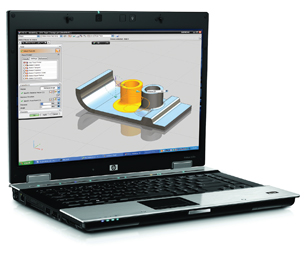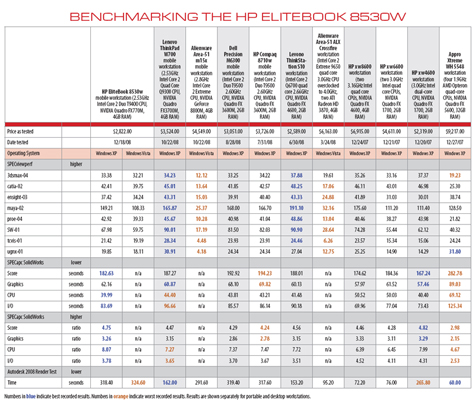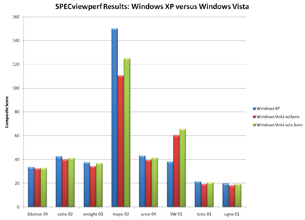HP EliteBook 8530w Mobile Workstation Includes Brains and Beauty
The new 8530w mobile workstation from HP proves itself the price/performance leader under both Windows XP and Vista.
December 4, 2001
By David Cohn
 The HP EliteBook 8530w is an elegant successor to the HP Compaq 8510w and benefits from a HPDuraCase, a brushed anodized aluminum exterior bonded to a magnesium alloy chassis |
HP has long been a leader. The company’s workstations—both desktop and portable—have always been absolutely superb. We know this first hand, since DE has reviewed nearly every system in both HP’s desktop and portable workstation lines.
The HP EliteBook 8530w is an elegant successor to the HP Compaq 8510w, which itself is the smaller sibling of the 8710w we reviewed just a few months ago (see DE October 2008). For those looking for a 17-in. notebook, HP also now offers the EliteBook 8730w, which we plan to review in the near future.
For the new EliteBook line, HP has eschewed the all-gray scheme of its Compaq branded mobile workstations for the new HP DuraCase, a brushed anodized aluminum exterior bonded to a magnesium alloy chassis. This gives the new notebook a more sculptural shape, but the brushed aluminum seems a bit more difficult to keep clean—fingerprints are quite noticeable—and the system lacks the icons along the top of the palm rest that formerly identified the ports on the edge below. I’ve always lauded HP for this simple but effective labeling, but according to an HP representative we spoke with, the icons were eliminated on the new model because the contrasting brushed aluminum and matte black finish would have required two separate silk-screening processes. Instead, identifying icons are printed adjacent to each port, but are so tiny that most users will simply identify each port by its shape.
The new case style gives the 8530w cleaner lines that make the system look smaller in spite of the fact that it has virtually the same dimensions as its predecessor: 14.0 in. x 10.4 in. x 1.1 in. and 6.3 pounds plus the AC adapter. Our evaluation unit came powered by a 2.53GHz Intel Core 2 Duo T9400 CPU with 6MB of L2 cache, backed by a Mobile Intel PM45 Express Chipset. Other CPU options range from a 2.26GHz Core 2 Duo P8400 to the 3.06GHz Intel Core 2 Duo Extreme X9100 or the 2.53GHz Intel Quad Extreme QX9300.
Raising the brushed aluminum lid reveals a full-size 86-key keyboard set in a recessed matte-black deck above a brushed aluminum palm rest. Touch-sensitive controls similar to those on the 8510w and 8710w occupy a strip in the brushed aluminum panel above the keyboard while a touchpad with a dedicated scroll area and three mouse buttons is centered in the palm rest. There’s also a black pointing stick above the B key in the keyboard, with its own complement of three buttons just below the spacebar as well as a fingerprint sensor in the lower right corner of the palm rest.
 |
Indicator lights for wireless, power, battery, and hard drive activity are located on the front-left edge of the case, where you’ll also find the system’s speakers, powered by a high-definition 24-bit audio chipset. Touch-sensitive controls in the strip above the keyboard let you adjust the volume or mute the speakers as well as toggle the wireless functions, display the HP Info Center dialog (which provides quick access to online documentation), and let you configure video and power settings and then activate a predefined presentation.
The EliteBook 8530w is available with two different 15.4-in. anti-glare displays, a 1680x1050 resolution XSXGA+ and the beautiful 1920x1200 WUXGA display included in the system we received. An ambient light sensor can automatically adjust the LCD backlight for optimal viewing in different lighting conditions. HP also offers a choice between an ATI Mobility FireGL V5700 graphics accelerator with 256MB of RAM or the NVIDIA Quadro FX 770M with 512MB of dedicated graphics memory included in our evaluation unit. Both support external monitors with resolutions up to 2048x1536 when connected to the system’s VGA port, HD displays up to 1920x1080 connected to the system’s HDMI port, and either 1920x1200 for single-link DVI monitors or 2560x1600 for dual-link DVI monitors connected to the DVI port in HP’s optional docking station. In spite of changes to the case, the EliteBook uses the same docking station as the earlier HP Compaq mobile workstation series.
HP also offers numerous hard drive options including 5400rpm drives ranging from 120GB to 250GB and 7200rpm drives from 160GB to 320GB capacity. Our evaluation unit came with a 160GB 7200rpm Toshiba SMART SATA II hard drive with a 16MB buffer. Optical drive options range from a standard DVD-ROM drive to the Blu-RayR/RE DVD+/-RW SuperMulti dual-layer drive included in our system.
 After completing our tests under Vista, we swapped hard drives (easily done in less than a minute)and repeated our tests using XP, making this our most extensive benchmark testing ever. After completing our tests under Vista, we swapped hard drives (easily done in less than a minute)and repeated our tests using XP, making this our most extensive benchmark testing ever. |
New Additions
New to the EliteBook line is a small LED centered in the bezel above the display. The LED pops out at the press of a button to illuminate the keyboard in low-light conditions; pushing the LED back into the case turns it off. Our system also came with an optional 2Mp webcam with preinstalled software to take a photo or record video. The webcam can also be used with instant messaging software.
In addition, HP included HP Presto Biz-Card, software to transform business cards into a usable database of contact information. Although this software is also available directly from NewSoft for use with its own or third-party business card and flatbed scanners, the special HP version is designed to work with the EliteBook. A small slot along the front edge of the computer holds the business card. You then close the lid until it’s open only about 30 degrees, with beeping tones guiding you into position. Once at the correct angle (which can be frustrating), the software automatically grabs an image of the business card, processes it using optical character recognition (OCR), and figures out which data goes into the appropriate data fields. It did a decent job with most horizontal business cards we tried, but was often frustrated by vertically oriented cards. Of course, you can edit data the OCR doesn’t get right and then export it to a wide variety of contact management applications. While a neat concept, I found it less practical than just typing info into my PIM software.
The expansion ports on the 8530w are arranged much the same way as on previous models. Along the right side of the case are headphone and microphone jacks, a pair of USB ports, the optical drive bay, the modem jack, and a security cable slot. The optical drive can be swapped out for a second hard drive. Along the left side are an ExpressCard slot and a media card reader that handles Smart Card (SC), MultiMedia Card (MMC), Secure Digital (SD), Memory Stick Duo (MS Duo), Memory Stick (MS), Memory Stick Pro (MSpro), and xD-Picture Card formats. There’s also a port for connecting to IEEE 1394 or 1394a devices such as camcorders, an eSATA port for external drives, an HDMI port for external video/audio devices such as HD televisions, the RJ-45 network port, and two additional USB ports. The back of the case has just a power connector and external VGA port, with the remainder taken up by the battery, shaped slightly different than in earlier models. The bottom of the case provides access to the battery release latches, docking port connector, optional battery connector, business card holder, and internal components such as the hard drive and memory modules.
The EliteBook also accepts an optional mobile broadband wireless card ($125) with service provided by either AT&T or Verizon. Our system came with a standard 8-cell (73 Whr) lithium-ion battery that powered the system for 3 hours and 21 minutes in our battery run-down test. Interestingly, the battery lasted only 3 hours under Vista. HP also offers a high-capacity battery that replaces the standard battery and a wedge-shaped 12-cell ultra-capacity battery that attaches to the bottom of the system and can increase total battery life to as much as 9 hours.
| HP EliteBook 8530w >Price:$2,822 as tested ($2,229 base price) >Size: 14.0 in. x 10.4 in. x 1.1 in. (WxDxH) notebook >Weight: 6.3 pounds plus power supply (depending on configuration) >CPU: 2.53GHz Intel Core 2 Duo (T9400) w/6MB L2 cache >Memory: 4GB 800MHz DDR2 SDRAM (8GB max) >Graphics: NVIDIA Quadro FX 770M w/512MB memory >LCD: 15.4 in. WUXGA+ 1920x1200 >Hard Disk: 160GB, 7200rpm Toshiba 2.5-inch SMART SATA II w/ 16MB buffer >Floppy: none >Optical: Blu-Ray R/RE DVD+/-RW SuperMulti DL >Audio: microphone and headphone jacks, built-in microphone and speakers >Network: integrated Intel Gigabit Ethernet (10/100/1000 NIC); Intel 802.11a/b/g draft-n wireless LAN; optional integrated Bluetooth 2.0; optional Mobile Broadband (AT&T or Verizon) >Modem: 56K V.92 Modem >Other: four USB 2.0, one mini IEEE 1394a Firewire, HDMI video/audio out, eSATA, Media Card reader (SC, SD, MMC, MS/Pro, XD), one Express Card/54 slot, 15-pin VGA, optional 2MP webcam >Keyboard: integrated 86-key keyboard >Pointing device: integrated 3-button touchpad and pointing stick, fingerprint reader |
Most Extensive Benchma rk Testing Ever
HP pre-installed Windows Vista Business Edition, making this the first HP mobile workstation we’ve tested using this operating system. Under Vista, we tested first with the full Aero interface. But since Vista’s Desktop Window Manager (DWM), the underlying architecture behind Aero, is essentially an additional application that all graphics must pass through, it can reduce graphic performance by up to 10 percent. For this reason, we switched to the Windows Classic theme (effectively disabling Vista’s DWM) and then ran our tests again.
To get an even better comparison, HP shipped us a replacement hard drive with Windows XP pre-installed. After completing our tests under Vista, we swapped hard drives (easily done in less than a minute) and repeated our tests using XP, making this our most extensive benchmark testing ever.
The results were quite surprising. Whereas previous testing showed a significant difference in performance between Vista and XP, those differences have largely vanished. This parity is largely due to video card manufacturers having been able to optimize their Vista drivers over time. On the SPECviewperf test, which looks solely at graphics performance, the HP EliteBook 8530w proved itself nearly equal to the otherportable workstations we’ve tested recently, in spite of the fact that its graphics card was more modest than those found in the other machines.
On our SolidWorks test under Windows XP, which is more of a real-world test (and breaks out graphics, CPU, and I/O performance separately from the overall score), the EliteBook proved to be the fastest mobile workstation we’ve seen to date. But it’s also now clear that our SolidWorks results under Vista are flawed. We will be updating this test for future reviews.
The AutoCAD rendering test results were exactly as expected. The system showed the advantage of having two CPU cores, finishing the rendering in half the time compared to a system with a single-core processor and taking twice as long as one equipped with a quad-core CPU. The rendering took slightly longer to complete when running Auto-CAD under Vista than Windows XP, but the difference was minimal.
Our test results confirmed that Aero did indeed reduce benchmark performance, but not nearly as much as we expected. Although users can mitigate this by disabling Aero, doing so eliminates many of the visual aspects of the operating system that make Vista so attractive. Our table shows the EliteBook’s viewperf results under all three test conditions—Windows XP, Vista with Aero, and Vista with the DMW disabled. The full benchmark results in the accompanying table show both the XP and Vista result scores, but since most users will likely keep Aero enabled, it is those numbers we’ve included. Note too that we’ve now separated the test results for mobile and desktop workstations and indicated the operating system used. The best and worst scores are shown separately for these two classes of workstations.
Perhaps even more impressive than the benchmark results is the price. A base system with a 2.26GHz CPU, WSXGA+ display, the ATI graphics board and a plain DVD-ROM drive would cost just $1,479. Our evaluation unit priced out online at $2,822, making the HP EliteBook 8530w the most affordable mobile workstation we’ve tested and the new price/performance leader.
HP backs the EliteBook 8530w with a limited three-year warranty on parts and labor and offers more extensive coverage, including wide range accidental damage, theft/loss, and data protection services for an additional charge. Buyers can choose from 32- and 64-bit versions of Windows Vista Business or Vista Ultimate, downgrade to Windows XP Professional, or even purchase a system with FreeDOS pre-installed. In terms of price, performance, and portability, the HP EliteBook 8530w is a winner.
More Info:
HP
Houston, TX
800-345-1518
Contributing Editor David Cohn is a computer consultant and technical writer based in Bellingham, WA, and has been benchmarking PCs since 1984. He’s the former Editor-in-Chief of Engineering Automation Report and CADCAMNet, and the author of more than a dozen books. Please send comments about this article to [email protected]. You can also contact David at [email protected].
Subscribe to our FREE magazine, FREE email newsletters or both!
About the Author
David Cohn is a consultant and technical writer based in Bellingham, WA, and has been benchmarking PCs since 1984. He is a Contributing Editor to Digital Engineering, the former senior content manager at 4D Technologies, and the author of more than a dozen books. Email at [email protected] or visit his website at www.dscohn.com.
Follow DE





